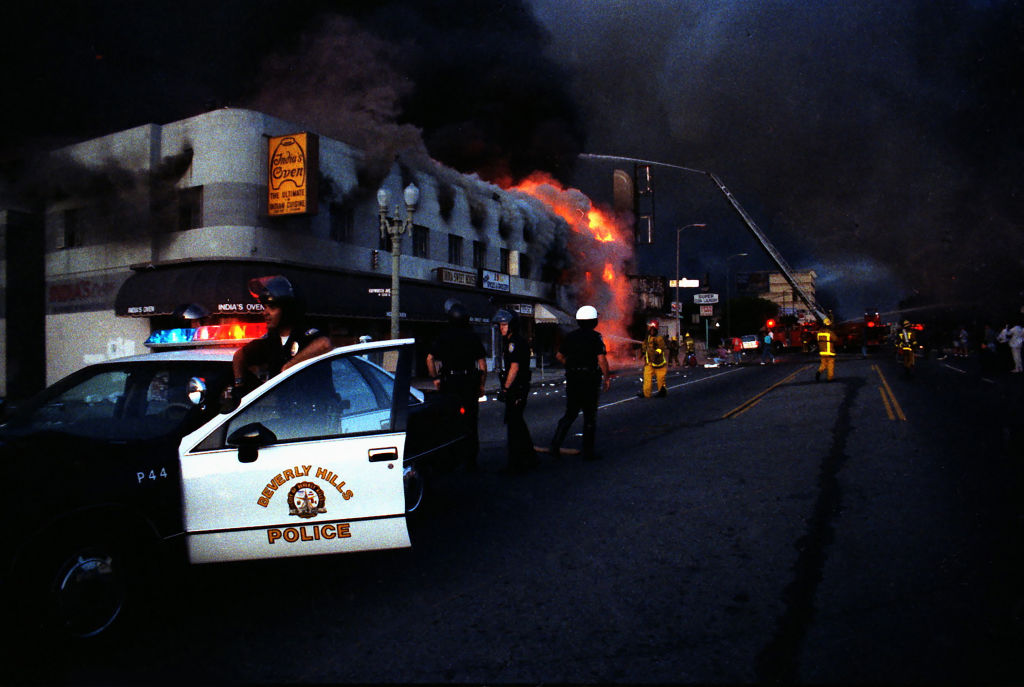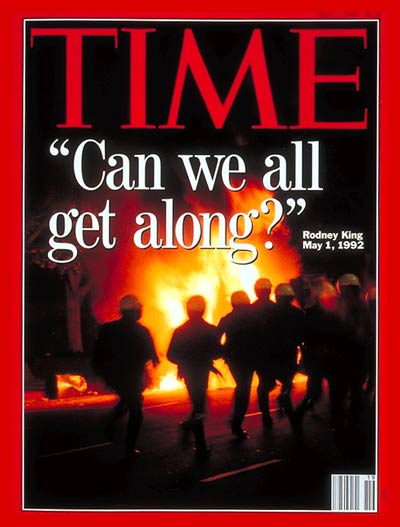
When a jury announced on April 29, 1992, that four Los Angeles police officers had been acquitted of assault with a deadly weapon in the beating of an unarmed Black man named Rodney King, America was shocked. In Los Angeles, the news sparked a five-day rebellion.
More than 10,000 National Guardsmen and 2,000 federal troops were deployed to quell what morphed into the most destructive urban rebellion in the city since 1965. More than 50 people died, more than 2,000 were injured, and damage to area buildings came with costs totaling about $1 billion.
After all, there was video of what happened, filmed by a bystander named George Holliday. It showed the police beating Rodney King some 50 times with batons and shooting him with tasers. On May 1, President George H.W. Bush addressed the nation, saying he and First Lady Barbara Bush were “stunned,” as “it was hard to understand how the verdict could possibly square with the video.” As the historian Elizabeth Hinton writes in America On Fire: The Untold History of Police Violence, “This was the first viral video of police brutality.”
Read more: The Police Misconduct Caught on Tape Before Rodney King
One the 30th anniversary of the acquittal and the rebellion, video footage of police brutality is still driving the national conversation—from Darnella Frazier’s video of a white police officer murdering George Floyd by kneeling on his neck in May 2020, to the more recent video of a white police officer shooting Patrick Lyoya in the back of his head in April 2022. Experts on policing tell TIME that while changes were made to improve oversight of the LAPD following the acquittal, the biggest legacy of the uprisings was in the way the video helped open white Americans’ eyes to police brutality and to the challenges that African Americans can face with police. But that awareness has not always translated to action.
“In 1992, I think people that had not directly experienced police violence saw something that shocked them; I think communities that were used to police violence were like, ‘thank God someone finally understands what’s happening,’” says Aaron Roussell, sociologist and author of The Limits of Community Policing: Civilian Power and Police Accountability in Black and Brown Los Angeles. “But I don’t know that the promise of that has been borne out.”
Following the rebellion in Los Angeles, there were efforts to reform the leadership of the LAPD. In June 1992, Los Angeles voters approved a ballot measure that limited their police chief to two five-year terms, compared to life tenure they had before. Then-police chief Daryl Gates was ousted and Philadelphia Police Chief Willie Williams came to run the Los Angeles Police Department, becoming the city’s first Black police chief.
“One of the complaints was that the LAPD and the Chief of Police had garnered so much power in the city and the ability to be insulated from oversight, because there’s no real way to oversee the chief because they can’t be fired,” says Max Felker-Kantor, historian and author of Policing Los Angeles.
The ballot measure also added civilians to the “board of rights” panels that could hold disciplinary hearings when complaints were made against an officer. Previously, it was only police officers on these kinds of panels, so they were essentially policing themselves.
But it would take another scandal for the Los Angeles Police Department to undergo its most significant reform. In the late 1990s, an investigation exposed corruption in the department’s anti-gang unit, from excessive use of force to stealing drugs from an evidence room, so in 2000, the Los Angeles Police Department agreed to enter into a consent decree with the department of justice, allowing for a federal judge to oversee its activities in what the Harvard Kennedy School called “one of the most ambitious experiments in police reform ever attempted in an American city.” Changes included quarterly discipline reports and a database tracking each officers’ use of force and civilian complaints to serve as an early warning system for risky behavior.
Activists in Los Angeles say that the increase in attention to policing did not come with an increase in resources to help the impoverished South Central Los Angeles neighborhood rebuild after the rebellion, from school funding to health care. In fact, an organization called Rebuild LA, which formed shortly after the uprising in May 1992, invested less than $400 million in a revitalization project that experts estimated would cost $4-6 billion to do properly, according to Hinton’s America on Fire.
“Reforms didn’t go far enough,” says Melina Abdullah, co-founder of the L.A. chapter of Black Lives Matter. “[In 1992,] you see pushes on the ground for investment in resources, like jobs in South Central Los Angeles. And unfortunately, we wound up with an expanded police [force] that now gets more money, under the guise of training, than we do real investment in the community.”

“The changes that resulted, while important, did not actually question or address the role of the police in the city,” says Kantor. “There’s some changes in oversight, but not entirely; it didn’t really ask those fundamental questions about what the police do [and] why. Those are the questions that came up post George Floyd.”
The difficulty of answering those questions was something TIME foresaw three decades ago, when the magazine featured King’s famous plea—”Can we all get along?”—on the cover of the May 11, 1992, issue. “As appalling as the carnage was, it seemed to signal something worse: a final loss of faith by black Americans in the fairness of the criminal-justice system and hence in the rule of law itself,” the magazine reported. “It will be easier to clean up the rubble than to heal the mistrust and anger that caused it.”
Correction, April 29
The original version of this story misstated the last name of scholar Aaron Roussell. It’s Roussell not Rousell.
More Must-Reads from TIME
- How Donald Trump Won
- The Best Inventions of 2024
- Why Sleep Is the Key to Living Longer
- Robert Zemeckis Just Wants to Move You
- How to Break 8 Toxic Communication Habits
- Nicola Coughlan Bet on Herself—And Won
- Why Vinegar Is So Good for You
- Meet TIME's Newest Class of Next Generation Leaders
Write to Olivia B. Waxman at olivia.waxman@time.com